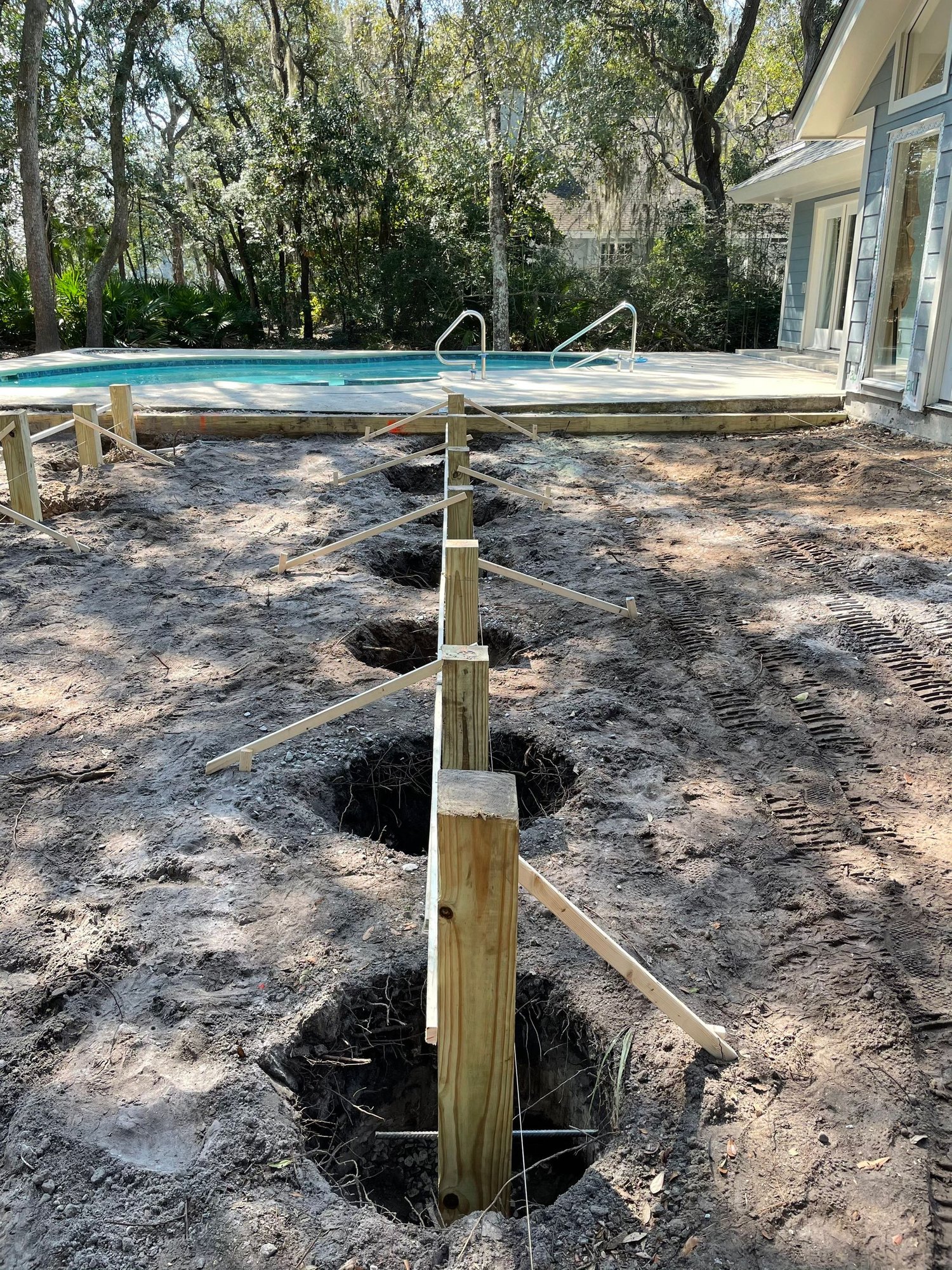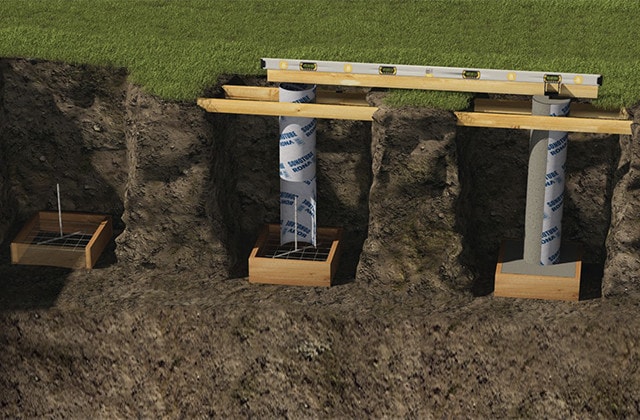From Concept to Concrete: The Vital Function of Deck Footings in Sturdy and Safe Decks
Wiki Article
Picking the Right Deck Footings for Security and Resilience
The long life and safety and security of your deck depend heavily on the type of footings you choose, as they give the necessary assistance and security to withstand the examination of time. In this discussion, we will discover the different types of deck grounds, consider the important factors to consider when making a choice, and dig right into the pros and cons of different choices.Kinds of Deck Grounds
There are numerous sorts of deck grounds that can be made use of, each offering one-of-a-kind benefits and considerations. One common type of ground is the concrete pier footing. These grounds consist of a round opening full of concrete, which gives a strong foundation for the deck blog posts. Concrete pier grounds are reasonably simple to set up and use superb stability, making them a prominent choice for numerous deck jobs.An additional sort of ground is the helical heap footing. Helical stacks are steel shafts with helical plates affixed to them. These grounds are installed by screwing them into the ground, which creates a secure foundation for the deck. Helical heap grounds are perfect for locations with tough dirt problems, as they can be set up in almost any sort of soil. If needed., they also allow for very easy adjustment and progressing of the deck.
Alternatively, some home builders select precast concrete footings. These grounds are made of durable concrete and be available in numerous sizes and shapes to suit various deck designs. Precast concrete grounds are convenient to set up and provide a steady base for the deck framework.
Lastly, another choice is the post-in-anchor footing system. This type of footing involves driving a steel anchor right into the ground and connecting it to the deck post. It offers versatility in terms of positioning the deck blog posts and is ideal for decks with light-weight structures.
When picking the best type of deck footing, it is vital to consider variables such as soil problems, deck tons, and local building regulations (Deck Footings). Consulting with a specialist service provider or structural engineer can aid make certain the appropriate footing is selected for a secure and steady deck
Elements to Think About When Choosing Grounds
When selecting the proper grounds for a deck, it is vital to meticulously consider numerous variables such as dirt conditions, deck lots, and adherence to regional structure codes. These variables play a significant role in ensuring the security and toughness of the deck framework.The type of soil on which the deck will certainly be constructed identifies the kind of grounds required. On the other hand, decks built on clay or large dirts may call for grounds that can suit the soil's propensity to increase and contract.
An additional important variable is the deck load. The weight of the deck, consisting of the products used and any potential online loads such as furniture or events, must be taken into consideration when picking footings. The grounds must be developed to bear the weight of the deck and distribute it evenly to stop any architectural issues or failures.
Finally, adherence to local building ordinance is critical. Building codes vary from area to region, and it is necessary to follow the details requirements set by the neighborhood authorities. Deck Footings. These codes make sure that the deck is constructed safely and fulfills the needed standards for architectural stability and load-bearing capacity
Concrete Grounds: Benefits And Drawbacks

Concrete footings provide numerous advantages and downsides when used as the foundation for a deck. On the silver lining, concrete grounds offer exceptional stability and resilience. Concrete is a inflexible and strong product that can support hefty lots and endure various weather condition problems. It also has a long lifespan, making it a reliable selection for long-term use.
An additional benefit of concrete grounds is their flexibility. They can be poured into various sizes and shapes to suit different deck styles and configurations. Concrete grounds can be tailored to fit the particular requirements and needs of the deck structure.
However, there are additionally some disadvantages to using concrete grounds. One major downside is the expense and labor associated with their installation. Concrete footings need excavation and frequently require the support of heavy equipment. This can raise the general cost of the deck task and may call for professional assistance.

Helical Piers Vs. Sonotubes: Which Is Better?
In taking into consideration the structure alternatives for a deck, the contrast in between helical piers and sonotubes is crucial in figuring out the exceptional selection. They are twisted right into the ground making use of hydraulic machinery, providing a durable and stable structure for the deck.The helical plates on the piers create a strong grip with the dirt, shifting or preventing any kind of activity of the deck. Sonotubes, on the other hand, rely entirely on the concrete filling for stability, which might not use the very same level of toughness and resistance.
In regards to setup, helical piers are fairly simpler and faster to mount contrasted to sonotubes. The hydraulic machinery utilized to twist the piers right into the ground makes certain a effective and quick process. Sonotubes, on the other hand, require excavating openings and putting concrete, which can be labor-intensive and taxing.
In addition, helical piers are an even more find out here versatile choice. They can be used in More Info various dirt conditions and can be changed or strengthened if needed. Sonotubes, on the various other hand, may require additional support, such as rebar, in specific soil conditions or areas with high load needs.
Picking the Right Footings for Your Deck's Dimensions
For optimal architectural stability, it is vital to carefully pick the proper footings that straighten with the measurements of your deck. The measurements of your deck, including its elevation, size, and width, play a considerable function in determining the kind and dimension of grounds needed.When picking footings for your deck, it is important to consider the load-bearing ability of the dirt. The weight of the deck, integrated with the weight of any type of furnishings or people on it, puts in a substantial pressure on the footings (Deck Footings). It is essential to pick grounds that can sufficiently sustain this weight without shifting or sinking over time.
The shapes and size of the footings should also be taken into consideration. Larger decks with better measurements need larger footings to supply enough stability and assistance. The shape of the footings, whether they are square or rounded, depends on the style and format of the deck. In addition, the depth at which the grounds are mounted ought to be established based upon the frost line in your region to stop any heaving or shifting due to freezing temperature levels.
Verdict
To conclude, choosing the ideal deck footings is essential for making sure security and durability. Factors such as the type of grounds, the deck's dimensions, and the pros and cons of different options should be thought about. Concrete grounds supply stamina and long life, however may be much more taxing and pricey to mount. Helical piers and sonotubes have their own advantages and negative aspects. Eventually, picking the ideal best site grounds for your deck's certain requirements is vital for a successful and lasting structure.These grounds are composed of a round hole filled up with concrete, which gives a strong foundation for the deck posts. Concrete pier grounds are relatively easy to install and offer excellent stability, making them a popular choice for numerous deck jobs.
Precast concrete grounds are hassle-free to mount and supply a secure base for the deck framework.
It supplies flexibility in terms of placing the deck messages and is appropriate for decks with lightweight structures.
Concrete grounds offer numerous benefits and downsides when utilized as the foundation for a deck.
Report this wiki page